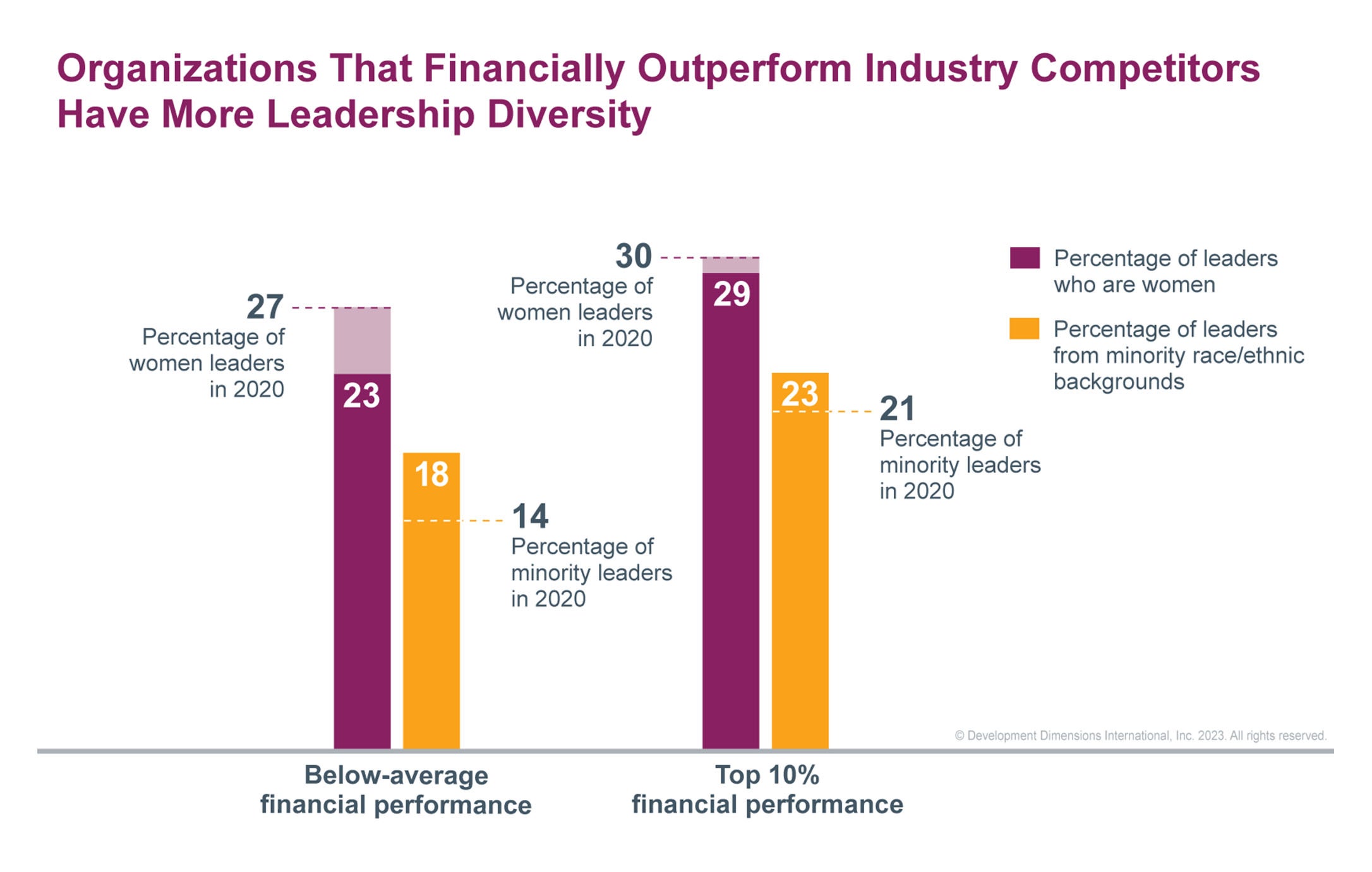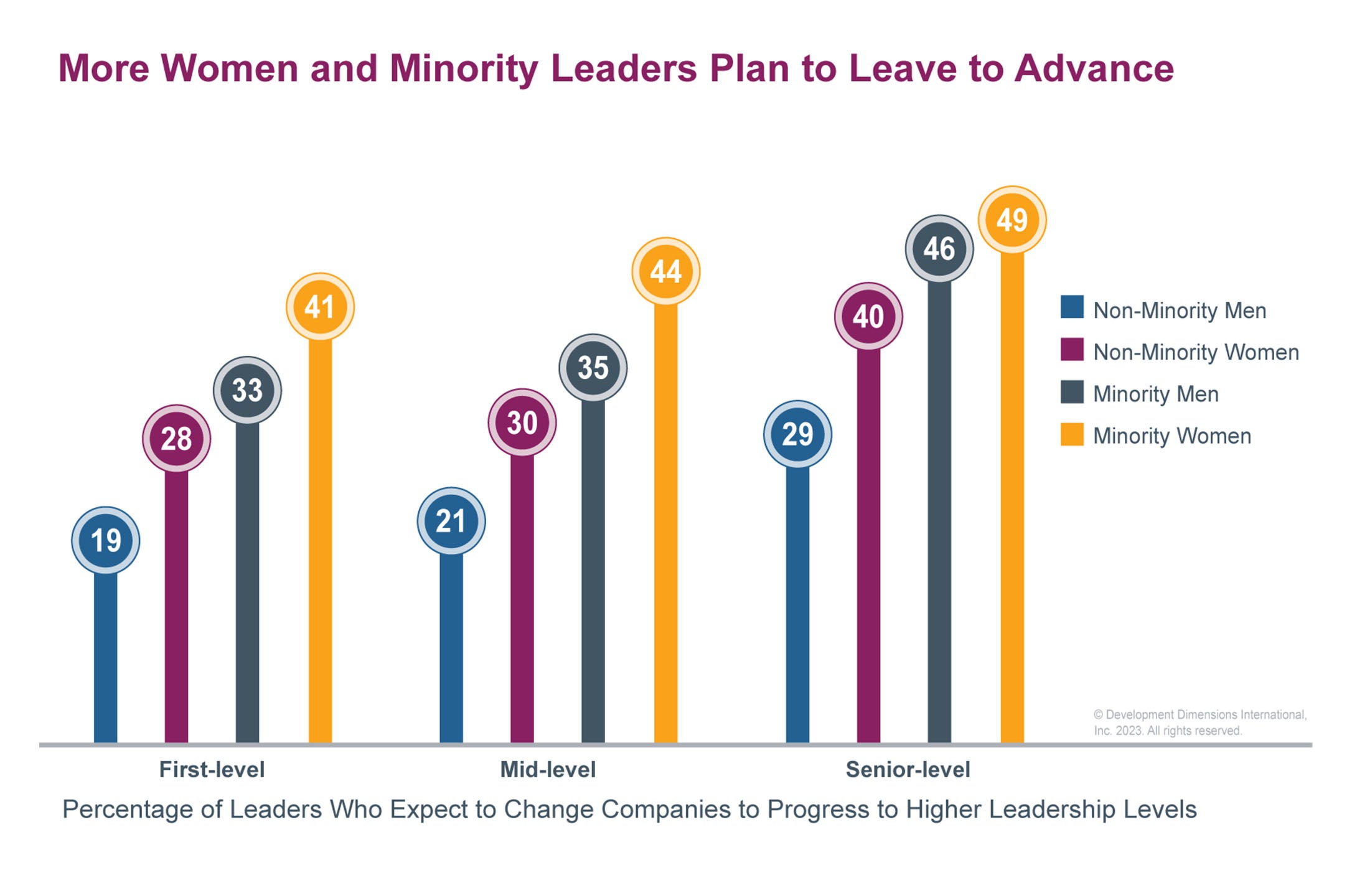Turnover is a natural part of a growing organization. But high turnover—especially among leaders—can cause significant disruption to teams and productivity. According to DDI's Global Leadership Forecast 2023, 54% of companies experienced an increased rate of turnover in the last year. Turnover volatility has become a wake-up call to organizations, highlighting the importance of having a retention strategy to minimize turnover and its negative consequences. The problem? Many HR professionals and leaders don’t know where to start. They need best HR practices for leader retention, which we’ll cover in this blog.

Why Losing Leaders Is Costly
A high leader turnover rate can be costly to companies, slowing productivity and putting pressure on HR departments to find replacements quickly.
In our latest Global Leadership Forecast research, which surveyed more than 13,000 leaders across 1,500+ organizations globally, we learned the top challenges plaguing CEOs. The top three biggest CEO challenges are talent problems:
- Attracting and retaining top talent
- Developing the next generation of leaders
- Maintaining an engaged workforce
But these talent problems can be solved. How? Staying ahead of talent trends, having employee retention goals, and learning leadership best practices can help. These can lead HR professionals to identify opportunities to plan for future leader talent needs.
Importance of Retaining Diverse Leaders
Organizations are paying increasing attention to the diverse makeup of their leadership team. Why? For starters, having diversity opens the door for diverse perspectives and ideas.

There are clear benefits to diversity in leadership roles. Our Diversity, Equity, and Inclusion Report 2023 found that organizations that financially outperform industry competitors have more leadership diversity.
Companies with more diversity in leadership also are more likely to be on the list of most admired companies. Diversity could make it easier to attract talent.
Though there are many advantages to having diversity in leadership, organizations face challenges retaining diverse leaders. In our report, we found that at every level of leadership, women and minorities are significantly more likely to say they need to change companies to advance their careers.
When diverse leaders leave, they take with them their experiences, organization knowledge, and diverse perspectives. Exiting leaders may also have a ripple effect, causing others to consider leaving as well.
Companies should pay attention to both hiring for diversity and retaining the diverse talent they do have.
What’s the Role of HR in Increasing Leader Retention?
HR personnel who are not thinking about increasing leader retention may be losing high-performing leaders without knowing it. But HR teams can improve leader retention by defining a strong leadership talent strategy.
A leadership talent strategy should include a robust plan on how to attract top leader talent from external sources. It should also include a succession planning process that identifies a strong pipeline for leadership.

In addition, this strategy should provide equal opportunities to all and should be audited on a regular basis to ensure women, minorities, and other underrepresented groups have equal opportunities in the talent pools for leadership roles. It should also include a process for developing those within the leadership succession pipeline so they receive equal opportunities to be successful in future roles.
And the strategy shouldn’t forget about high-potential employees. Regardless of gender or ethnic background, all high potentials should have access to the same programs. Ensuring everyone has equal opportunities to be prepared for their next opportunity is the key to success.
7 Best HR Practices for Leader Retention
Though retaining top leaders can be a challenge, there are HR best practices for leader retention. We found these seven best practices to directly impact leader intentions to stay in their organizations.

1. Define good performance for each role.
When success is not well defined, leaders may struggle to know how they are doing and question whether they can meet expectations. And when success is not defined for high-performing leaders especially, they may struggle with feeling accomplished and fulfilled in their roles.

2. Create clear career paths.
Leaders who have a clear understanding of their career paths are more likely to stay with their organization. Defining the long-term goal can improve leaders’ sense of motivation and give them clarity about what they are working towards.

3. Train leaders to express empathy.
Leaders who feel their direct manager genuinely cares about their well-being are more likely to stay with the company. They may feel their manager will work to develop them for future opportunities and trust that their best interests are in mind when decisions are made.

4. Prioritize development.
Leaders who have established high-quality, relevant development plans are more likely to stay. They may feel their organization is investing in their futures and see the benefits of further developing to be ready for future opportunities. Development planning also helps prepare talent for leadership transitions when the opportunity arises. Be sure employees document their career development plans so employees and leaders can refer to them easily on an ongoing basis.

5. Promote effective coaching.
When leaders receive effective coaching from their direct managers, they are more likely to stay with their organization. Coaching helps employees feel valued and develop a dialogue with their leader about their skills. These employees will feel more prepared when an opportunity arises because they have had more close supervision and feedback opportunities.
Though coaching may come naturally to some, it may be a skill that needs to be developed for others. So, offering consistent training opportunities to help leaders coach and develop others will ensure upcoming leaders get coaching when they need it.

6. Offer feedback regularly.
Those who receive feedback on their skills are more likely to stay. Why? Because they know they are gaining valuable insights into how they can grow to be more effective in the future.

7. Ensure leaders get a strong start.
Leaders who have the tools and information to do their jobs are more likely to stay. This starts with the onboarding process. Having essential access and tools required to perform early on may help leaders get up to speed faster and have a strong start in their roles.
Using a framework to check in with leaders to see if they have all the information and tools to be effective will help keep an ongoing pulse on needs as they arise. When more is needed, the HR team can partner with other departments to provide leaders with what they need to thrive.
Pay Attention to Warning Signs
Those who are at higher risk for leaving their organizations may show warning signs. Here are some signs to look for.
1. Leader Burnout
When a leader appears to be worn out or less energized by their work, they may be at risk of burnout. Burnout causes more stress and impedes leader work-life balance and engagement. When leaders are experiencing burnout, they are at a much higher risk for leaving their companies within a year.

In the Global Leadership Forecast 2023, we found that 70% of leaders under age 35 report feeling used up at the end of every day, with rates even higher among women and minorities.
Though experiencing burnout can lead to employee turnover, we also found that empathy can lessen some of its effects. When leaders feel used up at the end of the day, their likelihood of leaving decreases when they have an empathetic leader.
Why? Because empathetic leaders seek to understand what their direct reports are experiencing. They listen to the challenges of their team members and show they truly care about the well-being of their team members.
In contrast, our research also shows that when managers do not use interpersonal behaviors effectively—such as listening and responding with empathy—their direct reports are 1.8X more likely to report feeling used up at the end of the workday.
2. Disengagement
The relationship between employee engagement and retention is well known. When leaders are no longer engaged in their roles, they are more likely to leave. They may not find their jobs as rewarding as they used to be.
In our study, we found similar results. Specifically, we found overlap between drivers of retention and the drivers for engagement. Having up-to-date development plans, a clear career path, and a manager who cares about well-being all impact both engagement and retention.
When leaders are engaged in their roles, they are immersed in their work. They talk about it. They get things done. When they are disengaged, they will not be doing these things. Instead, they withdraw from their work or may do the bare minimum to get by.
By having regular check-ins to see how things are going, HR and leaders alike can identify opportunities to maintain leader engagement. And in turn, this can also help to minimize leader talent loss.
3. Poor Interactions
Leaders who are at higher risk for leaving may not be having quality interactions with others. Let’s face it—quality time is often hard to find in fast-paced work environments. Leaders may feel that they are not able to spend quality time with their team members, such as regular touchpoints, performance reviews, coaching conversations, and career aspiration discussions.
Leaders often think they need to spend significant time managing day-to-day tasks to ensure core work gets done. This day-to-day management can become a trade-off with teammate interactions. Without regular positive interactions, it can be challenging for leaders to build relationships by showing empathy and providing coaching.
In our research, we found that leaders who spend more time managing day-to-day tasks are twice as likely to consider leaving as leaders who spent more time interacting with their teams.
Human resource leaders can improve the frequency and quality of interactions. How? When HR encourages a company culture that values the human endeavor of leadership, leaders feel that they can spend more time on quality interactions.
HR can also implement training programs to help leaders develop critical skills, such as time management, delegation, and prioritizing, so they are able to spend more time having quality interactions.
4. Performance Ambiguity
Another warning sign has to do with understanding performance expectations. If leaders do not seem to understand what successful performance looks like in their role, they may find themselves unsure if they are doing well. When leaders are unclear what constitutes good performance, they may not feel their performance is critical to the success of the team.
They may also question how they could be a high performer if they are unclear what baseline success looks like. If they do not understand their own performance expectations, it may be hard to provide coaching and guidance to team members. And they may be fearful of misguiding others.
Though the signs of performance ambiguity may be difficult to see, leaders experiencing it may frequently ask if they are meeting expectations. Or, they may ask for more guidance on role clarity. HR should ensure that job descriptions are documented and outline the key tasks and competencies for each leadership role.
Additionally, having frequent performance and development conversations with leaders can help keep ambiguity to a minimum. Human resources teams can take steps to support leaders and make it easier for quality performance conversations to occur on a regular basis.
How to Keep Top Leaders
Retaining leadership talent is a top challenge organizations face today. Organizations must continue to focus on identifying and developing high-potential leaders to maintain and improve engagement. Leading with empathy and ensuring leaders have the knowledge and tools to be successful are also surefire ways to help keep your top leaders.
Check out the Global Leadership Forecast 2023 for more research and key trends on leadership today.
Rosey Rhyne is a senior research manager on DDI’s Center for Analytics and Behavioral Research (CABER) team. With a background in IO Psychology and practical experience in HR, Rosey is passionate about uncovering opportunities to improve the leadership experience through research.
Topics covered in this blog


